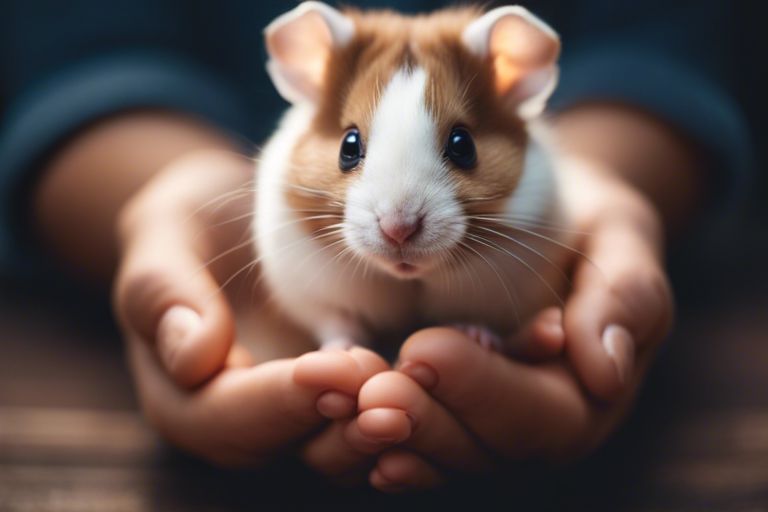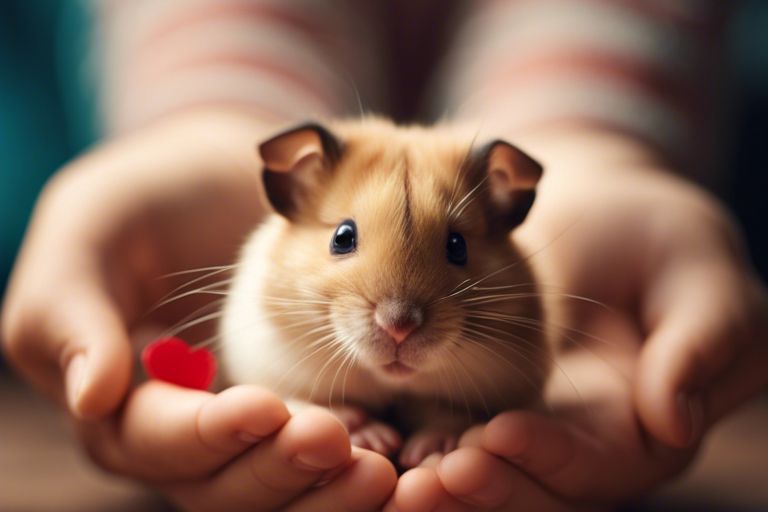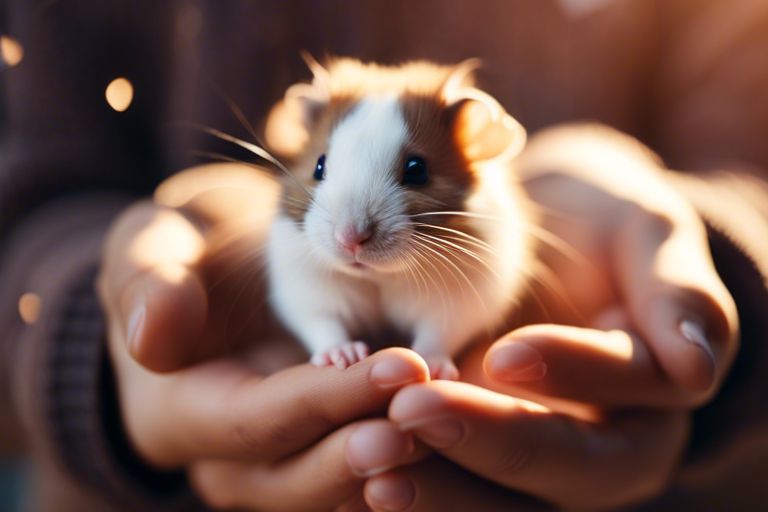It goes without saying that establishing a strong bond with your pet hamster is crucial for their well-being and happiness. In this informative post, we will provide you with expert tips on how to handle and interact with your furry friend to ensure a long-lasting and positive relationship. Whether you’re a new hamster owner or looking to improve your existing bond, these valuable insights will help you navigate the world of hamster handling with ease and confidence.

Understanding Your Hamster
Hamster Species and Their Differences
To truly understand your hamster, it is important to know that there are different species of hamsters, such as Syrian, Dwarf, and Chinese hamsters. Each species has its own unique characteristics and behaviors. Syrian hamsters are larger and more solitary, while Dwarf hamsters are smaller and can be kept in pairs or groups. Chinese hamsters have a slender body and a long tail. Understanding the species differences can help you tailor your care and handling techniques to suit your particular hamster’s needs.
Recognizing Hamster Behavior and Body Language
With hamsters, communication is not just about words – it’s about body language. Understanding your hamster’s behavior and body language is crucial in building a bond with your pet. Common behaviors to look out for include grooming, stretching, burrowing, and running on their wheel. Pay attention to their vocalizations, such as squeaking or hissing, as these can indicate different emotions or needs. By observing your hamster closely, you can learn to interpret their cues and respond accordingly.
Your hamster’s body language can tell you a lot about their mood and well-being. For example, a hamster that approaches you with ears forward and a relaxed body posture is likely curious and friendly. On the other hand, a hamster that is crouched, with ears flattened and teeth bared, may be feeling threatened or scared. By observing and understanding these cues, you can adjust your interactions with your hamster to ensure a positive and trusting relationship.
Creating a Safe and Welcoming Environment
Selecting the Right Cage and Placement
For a hamster to feel safe and secure, it is crucial to select the right cage and proper placement in your home. Opt for a cage that is spacious, well-ventilated, and escape-proof. Also, consider the bar spacing to prevent your hamster from getting stuck or escaping. Place the cage in a quiet area away from direct sunlight, drafts, and other pets to ensure your hamster feels comfortable and secure.
Providing Essential Hamster Amenities
Environment enrichment is key in creating a happy and healthy space for your hamster. To meet their important needs, provide a cozy bedding material for burrowing, a wheel for exercise, chew toys to maintain dental health, hiding spots for privacy, and a water bottle for hydration. By fulfilling these requirements, you will create a stimulating environment that promotes your hamster’s well-being.
To ensure your hamster feels safe and comfortable in their environment, it is important to provide them with a variety of amenities that cater to their natural instincts and behaviors. Hamsters are active animals that require mental stimulation and physical activity to thrive. By offering a diverse range of toys, hiding spots, and opportunities for exercise, you can create an enriching environment that will keep your hamster happy and healthy.
The Bonding Process
Approaching Your Hamster for the First Time
First impressions matter when trying to bond with your new hamster. When approaching your hamster for the first time, do so calmly and gently. Speak softly to reassure them. Allow your hamster to come to you on their terms, avoiding sudden movements or loud noises that can startle them. Offer treats from the palm of your hand to begin building positive associations with your presence.
Building Trust through Regular Interaction
Your hamster will start to trust you through regular, gentle interactions. Spend time near their cage, talking to them, and offering treats. Slowly introduce your hand into their space, letting them sniff and explore at their own pace. Eventually, you can try gently lifting them and letting them rest in your hands for short periods, always being careful and respectful of their boundaries.
Trust: Building trust with your hamster takes time and patience. Consistent, kind interactions will help your hamster feel safe and secure in your presence. Do not forget, every hamster is different, so it’s important to respect their individual personalities and boundaries as you work on building a strong bond with your pet.

Handling Techniques and Tips
For many hamster owners, handling their tiny pets can be a challenging task. However, with the right techniques and tips, you can bond with your furry friend and make the handling process a stress-free experience for both of you.
Proper Ways to Pick Up and Hold a Hamster
One of the most important aspects of handling a hamster is knowing the proper way to pick them up and hold them. To pick up your hamster, place one hand under its body for support and use your other hand to gently scoop it up. Make sure to avoid sudden movements and handle your hamster with care to prevent any stress or injuries. When holding your hamster, support its body to make it feel secure and comfortable in your hands.
Common Mistakes to Avoid
With handling hamsters, there are some common mistakes that owners should be aware of to ensure the safety and well-being of their pets. One common mistake to avoid is grabbing your hamster by its tail, as this can cause injury or distress to your furry friend. Another mistake is not washing your hands before handling your hamster, which can transfer harmful bacteria and lead to health issues for your pet. It is imperative to be gentle and patient when handling your hamster to build trust and a positive bonding experience.

Enhancing Your Bond
Interactive Activities and Games
Many hamster owners want to strengthen their bond with their pets through interactive activities and games. These can be simple activities like training your hamster to run through a maze, or playing with interactive toys designed for small pets. The key is to spend quality time engaging with your hamster in a way that is both fun and stimulating for them.
Treats and Rewards: What Works Best?
Any hamster owner knows the power of treats and rewards in building a strong bond with their pet. But not all treats are created equal. It’s important to find out what treats your hamster loves best, whether it’s a piece of fresh fruit, a small piece of vegetable, or a store-bought hamster treat. Pay attention to your hamster’s preferences and use their favorite treats as a reward for good behavior or during training sessions.
Activities such as puzzle feeders, treat balls, and foraging games can also be great ways to bond with your hamster while providing mental stimulation and reward. These activities tap into the natural instincts of your hamster to explore and forage for food, creating a positive and interactive experience that can enhance your bond with your pet.
Enhancing the bond with your hamster through interactive activities, engaging games, and the right treats and rewards can make your pet feel loved and secure in their environment. By spending quality time together and understanding what motivates and excites your hamster, you can strengthen your bond and create a happy and enriched life for your furry friend.
Health and Safety During Handling
Spotting Signs of Stress or Illness
Keep a close eye on your hamster’s behavior and physical appearance during handling sessions. Any changes in appetite, activity level, fur condition, or breathing patterns could be signs of stress or illness. If you notice anything unusual, consult your veterinarian immediately to ensure your pet’s well-being.
The Do’s and Don’ts of Hamster Handling
On the do’s side, do approach your hamster calmly and gently, allowing them to sniff and get used to your scent before attempting to pick them up. Do support your hamster’s body properly by placing one hand under their body and the other hand beneath their hindquarters. Don’t grab or squeeze your hamster, as this can cause them distress and possibly lead to injury. Don’t approach your hamster suddenly or startle them by making loud noises.
Understanding the proper handling techniques is crucial for both your safety and the well-being of your pet hamster. By being observant and respectful of your hamster’s cues, you can strengthen the bond between you and ensure a positive handling experience.
Final Words
As a reminder, proper handling and bonding with your hamster is necessary for building a trusting relationship and ensuring their well-being. By following the tips mentioned in this guide, such as approaching your hamster with patience and gentleness, providing a safe and comfortable environment, and offering treats as rewards, you can establish a strong bond with your furry friend. Remember to always prioritize the comfort and safety of your hamster during handling sessions, and with time and dedication, you will see your relationship flourish. Enjoy the journey of getting to know and bonding with your beloved pet hamster!
FAQ
Q: Why is it important to handle your hamster regularly?
A: Handling your hamster regularly is crucial for bonding, socialization, and overall well-being. It helps build trust between you and your pet and allows them to become more comfortable and tame.
Q: How should I pick up my hamster?
A: To pick up your hamster safely, place one hand under its body for support and use your other hand to gently scoop it up. Make sure to move slowly and avoid sudden movements to prevent startling your hamster.
Q: What is the best way to introduce yourself to a new hamster?
A: When introducing yourself to a new hamster, start by spending time near their cage to let them get used to your scent and presence. Gradually offer treats from your hand to encourage positive associations.
Q: How can I create a comfortable environment for handling my hamster?
A: To create a comfortable environment for handling your hamster, choose a quiet and calm area free from distractions. Make sure the room is at a comfortable temperature and provide a secure and stable surface to prevent falls.
Q: What should I do if my hamster seems scared or aggressive during handling?
A: If your hamster seems scared or aggressive during handling, it’s important to remain calm and gentle. Give them space and time to relax, and consider seeking advice from a veterinarian or animal behaviorist for further guidance.











